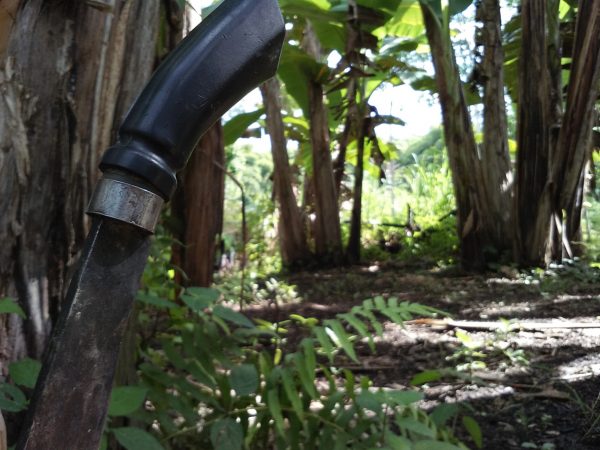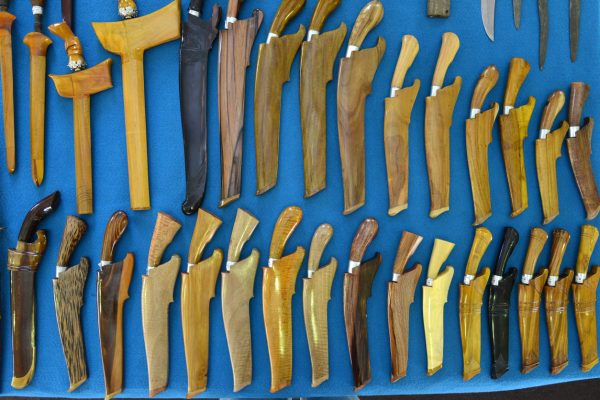The Parang Blade – The Perfect Survival Tool
Hailing from Southeast Asia, and Malaysia in particular, Parang is a traditional tool of the local peoples; it is most simply described as a large knife with many features that resemble a machete.
A Parang is much more than just a blade – this tool has a variety of uses and adaptations for different jobs and tasks in the wilderness.

In addition, this tool can be a fantastic asset for every time spent in the great outdoors. This fact is due to the parang’s ingenious design – a really iconic curvature of the blade and a construction that ensures a plethora of possible uses.
The Parang in Detail
Most standard parangs follow a set pattern and pre-established measurements that are really crucial for the effectiveness of the blade. These dimensions are often the same, with the whole of the parang being 30 centimeters long (12 inches).
The widest point of the blade is never wider than 5 centimeters (2 inches) to ensure the effectiveness. The proper weight for a parang is no more than a kilogram.
This blade needs to lay easy in the hand, and any weight above a kilo will be unwieldy and off-putting . As far as the handle goes, wood is the most preferable type. Woods is the natural material that is always easily gripped, no matter the weather conditions.
When you take a look at a parang, you will quickly notice the main focus of its unique appearance – the blade. Its design makes it a one of a kind tool for every outdoorsman, and the secret lies in that unique curvature. In fact, due to this curve, the blade has three effective edges – and each one can be used for a different task.
- These three edges, or three uses, are as follows:
The tip of the blade – This point is where the curve stops, ending in an abrupt angle and a delicate and sharp point. This point is perfect for a variety of delicate tasks for which you’d normally need a separate, thin blade.
Skinning, slicing, carving and even filleting are just a few of the uses where a slim and sharp tip comes in handy. For the Malaysian natives, this tip was often used for cutting tree bark – a delicate and difficult task.
The center of the blade – This point is also called “the belly”, due to its distinct shape. This is the centerpiece of a Parang, and also its toughest, most effective part. This protruding feature is a real work-horse and it is ideal for rugged, demanding tasks.
That’s also where the biggest similarity to a machete appears. Whether it’s wood cutting, bone smashing, or anything similar, the “belly” will definitely get the task done. When full force of the wielder is applied, the effectiveness is simply tremendous. But thanks to the design, the entire force of a swing is delivered to the center point of the blade, and that is the iconic curve.
The base of the blade – The flat, traditional base, the lowest point of a parang, has its uses as well, even if it doesn’t seem like it. But once you get the hang of it, you’ll realize that the base is a very important part – completing tasks that are more difficult with the tip or the belly.
Stake sharpening, carving, de-barking and even chopping, all these tasks are ideal for the base, due to the angle and the ideal exerted force on that part.
When you think about it, you can understand just why the parang can be an ideal addition to any outdoorsman’s kit. So many possible uses, a refined, tried and tested design, and its compact and lightweight design, make this tool one of a kind and very valuable. In the wilderness, whether camping, hiking or hunting, a parang is undoubtedly a useful tool to have by your side.
Most owners will claim that a parang blade is an evolved, better and refined version of a machete, excelling in more tasks and areas where the other cannot.
Setting up a camp, preparing kindling and firewood, clearing dense growth and brush, self defense or field dressing a kill – the parang can do it all, and with surprising effectiveness. Just these few tasks are a testament to why the parang blade is a must have for every serious outdoorsman.
Conclusion
Since becoming popular, this southeast Asian traditional tool has been successfully mass produced by a few of the leading outdoors equipment brands. Each one of them has its pros and cons, and they all offer a unique and distinct version of the blade. And what’s best – they’re all affordable.

When you consider it, you must admit that a parang is a blessing for any prolonged stay in the wilderness. Reliable, useful and easy to carry, you’ll quickly come to depend on it.
Matter of fact, a few of the leading survivalists popularized these blades and sparked a growing interest. Ray Mears, Bear Grylls and John Wiseman, all respectable outdoorsmen, spread the word about the parang. And from these men, a word of praise is certainly a testament to the effectiveness of a parang blade!





